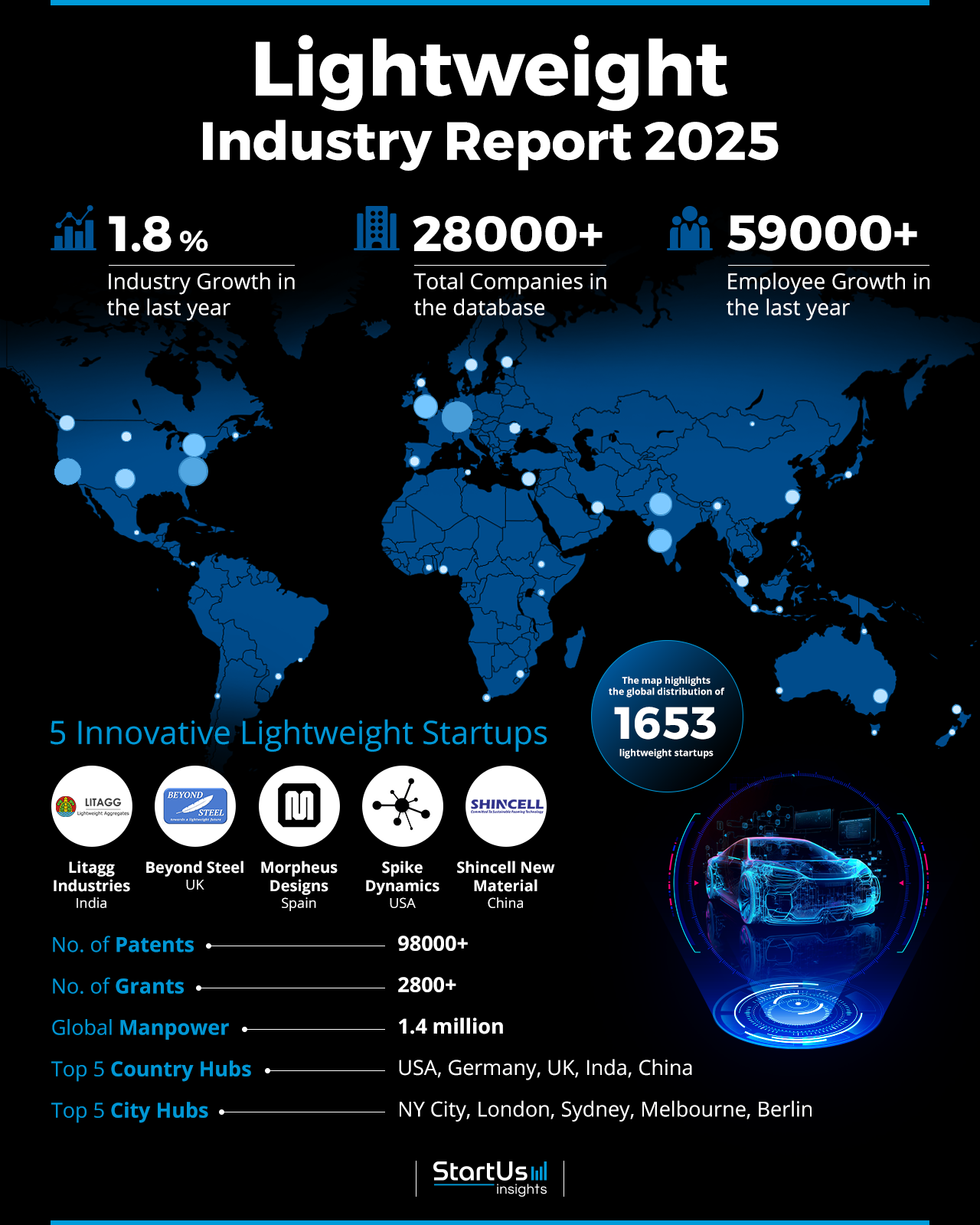The 2025 Lightweight Industry Report offers an overview of the global market and its role in driving innovation and sustainability in the automotive, aerospace, construction, and energy sectors. As industries prioritize energy efficiency, emissions reduction, and performance optimization, lightweight materials like advanced composites, aluminum alloys, magnesium, and carbon fiber become essential in manufacturing. The report explores key trends, emerging startups, and investment flows shaping the lightweight market landscape.
This lightweight report serves as a reference for stakeholders within the industry, investors, policymakers, and economic analysts, providing a snapshot of the industry’s health to map its trajectory for innovation and growth in the coming years.
StartUs Insights Lightweight Industry Report 2025
- Executive Summary
- Introduction to the Lightweight Report 2025
- What data is used in this Lightweight Report?
- Snapshot of the Global Lightweight Industry
- Funding Landscape in the Lightweight Industry
- Who is Investing in Lightweight Solutions?
- Emerging Trends in the Lightweight Industry
- 5 Innovative Lightweight Startups
Executive Summary: Lightweight Market Report 2025
This report is created using data obtained from the Big Data and AI-powered StartUs Insights Discovery Platform, covering more than 4.7 million global companies, as well as 20K+ technologies and emerging trends. We also analyzed a sample of 1600+ lightweight startups developing innovative solutions to present five examples from emerging lightweight industry trends.
- Industry Growth Overview: The lightweight industry is growing at an annual rate of 1.80%, encompassing over 28000 companies in the automotive, aerospace, construction, and energy sectors.
- Manpower & Employment Growth: The sector supports over 1.4 million professionals globally and has added more than 59000 employees recently.
- Patents & Grants: The industry holds over 98000 patents from 55000+ applicants and has secured over 2800 grants. This indicates significant innovation and financial support for research.
- Global Footprint: Key geographic hubs include the USA, Germany, the UK, India, and China, with prominent city hubs in New York, London, Sydney, Melbourne, and Berlin.
- Investment Landscape: With more than 8800 funding rounds, the sector has attracted over 5900 investors, averaging USD 14.2 million per round.
- Top Investors: Notable investors include Indorama Ventures, Coatue Management, Tiger Global Management, and more, with a combined investment value exceeding USD 2 billion.
- Startup Ecosystem: Five innovative startups are Litagg Industries (lightweight aggregates), Beyond Steel (composite body structures), Morpheus Designs (heat exchangers), Spike Dynamics (linear actuators), and Shincell New Material (lightweight polymer foams).
- Recommendations for Stakeholders: Investors should prioritize companies developing advanced materials and innovative manufacturing techniques that reduce weight without sacrificing strength or durability. Also, Entrepreneurs must create sustainable, recyclable solutions for high-demand sectors like automotive, aerospace, and construction. Companies should invest in R&D for lightweight composites, streamline production processes, and form strategic partnerships to enhance supply chains, reduce costs, and meet environmental standards.
Explore the Data-driven Lightweight Report for 2025
The Lightweight Industry Report 2025 uses data from the Discovery Platform and encapsulates the key metrics that underline the sector’s dynamic growth and innovation. Our database includes over 28000 companies and 1650 startups that highlight the industry’s innovative scope. With an annual growth rate of 1.80%, the market shows steady development. Over 98000 patents and 2800 grants represent ongoing research and funding efforts.
The global manpower in this field surpasses 1.4 million professionals, with employee growth adding more than 59000 individuals last year. Key geographical hubs driving lightweight innovation include the USA, Germany, the UK, India, and China. Whereas, leading city hubs are New York City, London, Sydney, Melbourne, and Berlin.
What data is used to create this lightweight report?
Based on the data provided by our Discovery Platform, we observe that the lightweight industry ranks among the top 5% in the following categories relative to all 20K topics in our database. These categories provide a comprehensive overview of the industry’s key metrics and inform the short-term future direction of the industry.
- News Coverage & Publications: The lightweight industry received extensive news coverage, with over 28000 publications released in the last year.
- Funding Rounds: Over 8800 funding rounds in total are recorded in our database.
- Manpower: With more than 1 million workers globally, the industry added over 59000 new employees in the past year.
- Patents: The sector has more than 98000 patents, which reflects significant innovation across lightweight technologies.
- Grants: It has secured over 2800 grants, demonstrating strong support from public and private funding sources.
- Yearly Global Search Growth: The yearly global search interest in the lightweight industry grew by 117.98%. This is an indication of increasing public and market attention.
A Snapshot of the Global Lightweight Industry
The lightweight industry grows at 1.80% annually, driven by startups and mature companies. Over 1600 startups exist in this ecosystem, with 750 in early stages and 1200 involved in mergers and acquisitions. Innovation remains central, with more than 98000 patents issued by over 55000 applicants, and a patent growth rate of 0.61%. China leads with over 31000 patents, followed by the USA with 26000.
Explore the Funding Landscape of the Lightweight Industry
The investment landscape is strong, with an average investment of USD 14.2 million per round. The sector has attracted more than 5900 investors, with over 8800 funding rounds successfully closed. This investment supports more than 2300 companies. The financial backing and consistent innovation highlight the lightweight industry’s role as a growing and dynamic sector within the global economy.
Who is Investing in Lightweight Solutions?
The top investors in the lightweight industry have collectively invested over USD 2 billion, reflecting strong financial support across different stages.
- Indorama Ventures has invested USD 314 million in 2 companies.
- Coatue Management has funded 6 companies, contributing USD 299.5 million.
- Tiger Global Management has supported 10 companies with a total investment of USD 286.9 million.
- SoftBank Vision Fund has invested USD 240.3 million in 3 companies.
- RPC Group has focused on 2 companies, investing USD 240 million.
- Apollo has allocated USD 207.5 million to 2 companies.
- L Catterton invested in 12 companies, totaling USD 206.9 million.
- Insight Partners has invested USD 202.7 million across 9 companies.
- IP Group allocated USD 200 million across 3 companies.
Access Top Lightweight Innovations & Trends with the Discovery Platform
Explore the emerging trends within the lightweight landscape along with the firmographic insights:
- The Electric Mobility segment has over 18K companies and employs more than 1 million people worldwide. This trend saw growth, adding 100K new employees last year, and is growing at an annual rate of 8.29%. The increased adoption of lightweight materials enhances energy efficiency in vehicles, improves battery performance and extends range.
- The Carbon Fiber segment includes over 4200 companies with more than 180K employees. Despite adding 8K new employees last year, its growth rate is declining at -4.06% annually. However, carbon fiber remains essential in industries like aerospace and automotive, where reducing weight while maintaining strength is critical.
- Focused on sustainability, CO2 Emission Reduction trend includes over 400 companies with around 24000 workers. The trend added 1K new employees last year, growing at an annual rate of 10.49%. As emissions regulations tighten, companies are increasingly investing in lightweight solutions to reduce carbon footprints.
5 Top Examples from 1600+ Innovative Lightweight Startups
The five innovative startups showcased below are picked based on data including the trend they operate within and their relevance, founding year, funding status, and more. Book a demo to find promising startups, emerging trends, or industry data specific to your company’s needs and objectives.
Litagg Industries builds Lightweight Aggregates
Indian startup Litagg Industries develops lightweight aggregates for construction applications that require reduced material weight and enhanced performance. It produces NODULLAR and SINTAGG, lightweight aggregates made from expanded clay and sintered fly ash, respectively. These materials form small, round pellets with an internal porous structure to offer high compressive strength, thermal insulation, and water resistance. Further, the startup provides sand-free pre-mixed mortar (LITAGG-SPM) to simplify waterproofing and reduce site preparation time. Litagg Industries supports sustainable construction by reducing the load on structures and improving energy efficiency in building projects.
Beyond Steel makes Composite Vehicle Body Structures
UK startup Beyond Steel builds modular composite body structures for automotive and commercial applications. It uses long-fiber composites to enhance mechanical performance, thermal insulation, and structural damping. The startup’s approach integrates carbon and glass fibers into its designs to offer lightweight solutions while balancing cost and durability.
Its body structures reduce mass, improve vehicle dynamics, and support crash safety through high torsion and bending stiffness. The modularity of these structures allows customization for various vehicle types, including battery-electric and internal-combustion models. Its platform reduces manufacturing complexity with a streamlined production process to enable rapid variant development and minimize capital expenditure. Beyond Steel addresses the demand for lighter, more energy-efficient vehicles without compromising safety or comfort.
Morpheus Designs offers Additive Manufactured Heat Exchangers
Spanish startup Morpheus Designs develops lightweight heat exchangers, optimized heat sinks, and TPMS-based water-oil coolers using additive manufacturing for thermal management and light-weighting. It uses tools like CFD, FEA, and 1D modeling to simulate real-world conditions to ensure efficient designs for the aerospace, automotive, and energy sectors. The startup offers CAD design and topology optimization to enhance product performance by reducing mass and system complexity while maintaining durability. Morpheus Designs delivers integrated, high-efficiency components that improve energy management and overall system performance across diverse applications.
Spike Dynamics provides Piezo-amplified Linear Actuators
US startup Spike Dynamics builds linear actuators, such as the Spiketon actuator and piezo-amplified locomotion systems, optimized for aerospace, robotics, automotive, and smart home applications. The startup’s technology uses ceramic materials and piezoelectric amplification for precise, high-speed motion control, even in extreme environments like outer space.
Spike actuators offer advantages like compact size, reduced weight, and resistance to radiation and extreme temperatures. These actuators support modular scalability and multi-axis movement to enhance flexibility for complex mechanical systems. Spike Dynamics enables lighter, more efficient, and sustainable solutions that improve operational efficiency across diverse applications.
Shincell New Material manufactures Lightweight Polymer Foams
Chinese startup Shincell New Material develops lightweight polymer foams using sustainable physical foaming processes. It uses nitrogen and carbon dioxide gases to create micro and nanobubbles within thermoplastic materials, which results in high-performance, low-environmental-impact microporous foam sheets. These foams, available in TPU, TPEE, and PEBAX variants, offer weight reduction, thermal insulation, and durability without relying on chemical blowing agents. Shincell New Material’s products support industries requiring eco-friendly materials to enhance energy efficiency while maintaining structural integrity across applications from automotive to consumer goods.
Gain Comprehensive Insights into Lightweight Trends, Startups, or Technologies
The lightweight industry is set for growth in 2025, driven by advancements in electric mobility, carbon reduction efforts, and high-performance materials like carbon fiber. Emerging trends emphasize sustainability, energy efficiency, and regulatory compliance, with companies focusing on innovation to meet market demands. Get in touch to explore all 1600+ startups and scaleups, as well as all industry trends impacting lightweight companies.



![AI in Automotive: A Strategic Guide for Industry Leaders [2025-2030]](https://www.startus-insights.com/wp-content/uploads/2025/03/AI-in-Automotive-SharedImg-StartUs-Insights-noresize-420x236.webp)






